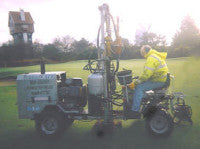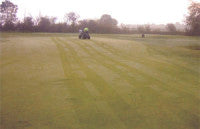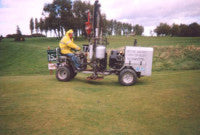A Tale of Three Courses
A Tale of Three Courses

Thorpeness, on the Suffolk coast and the most southerly of the three was suffering from compaction on the greens despite being built on sandy loam. Course Manager Ian Willett has been with the club since 1996 and taken the course to win the Eastern Region Environmental Award for the last two years.
"We were getting a black layer forming 8 to 9 inches down on the greens," he says. "David Stansfield, (the independent agronomist) took a core sample 18 inches down and the greens were pretty wet. In early spring, during heavy rain we'd get a bad smell."
Recommended by Stansfield, this was Terrain Aeration's second visit to Thorpeness. The company treated 7 greens in January 2004, with encouraging results.
"They certainly made an improvement last year," comments Willett. "We had players on the greens straight afterwards. We filled the probe holes with Lytag and rolled as many times as possible through the winter."
This time round Terrain treated 4 different greens and repeated the de-compaction process on 3 others. Using one of their Airforce machines they took the probe one metre down, and injected air under pressure to create underground fractures and fissures. Working at two metre spacings, to cover the whole area, the company injected dried, milled seaweed on the final air blast to keep the fractures open.
Also on the coast, but 160 miles north, the Harry Colt designed Grimsby golf course was also suffering a souring of the root zone (along with a build-up of thatch), but being clay based, less than perfect drainage was the culprit, according to Mr. Skingle the Secretary/Manager.

Henry Bechelet an agronomist with the S.T.R.I. travelled to Grimsby for his first encounter with Terrain Aeration's Airforce machine and the deep compressed air de-compaction treatment it performs. "I was impressed," he recalls. "It's an incredible machine and ideal for relieving deep seated compaction. I wouldn't recommend it for routine aeration, but if you do have specific problems it's very effective."
The inland links that is Lincoln Golf Course was suffering from a compaction pan 12 inches down under all the greens. Adrian Kitchinson, who has been with the club for 26 years, and Head Greenkeeper since last July thinks that following consistent verti-draining every year for the last 10 to 15 years, the finer soils had drifted down the drainage holes and formed a layer beyond reach of the machine.

Terrain Aeration arrived at Lincoln on 19th October, performed deep compressed air de-compaction treatment on 6 greens and were then rained off. They returned to do 4 more and have been invited back at the end of this year to treat the final 8 plus putting green.
"Our players had been using temporary greens but they were back on the proper ones as soon as Terrain Aeration had finished," reports Kitchinson. "The treated greens are a lot firmer."
For further information on the deep compressed air de-compaction treatment offered by Terrain Aeration, call the company on Tel: 01449 673783 or visit their website at: www.terrainaeration.co.uk
